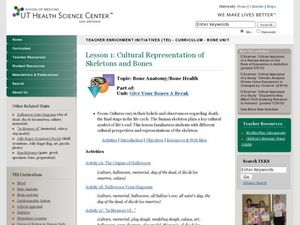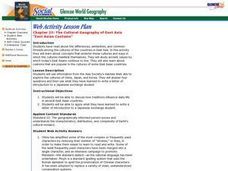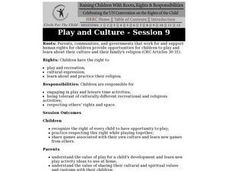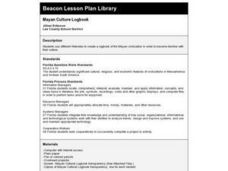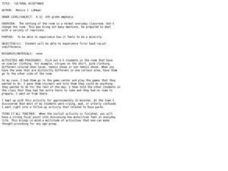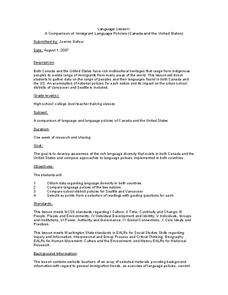Curated OER
Lesson 1: Culture and Resource Use
Young scholars research an aspect of Wabanaki culture that has persisted in Maine throughout the years. They write a conversation between a Wabanaki person and an English person that shows the different cultures and negotiates a solution...
Curated OER
Cultural Creation Myths
Young scholars analyze various cultural creation myths, write essays on three different societal stories, and create a play based upon one of those stories in this cross-curricular Theatre project for High School students. Cooperative...
Curated OER
Masai and I: A Cultural Comparison
Fourth graders orally share similarities and differences between their culture and the Masai culture based on their reading of Masai and I, by Virginia Kroll
Curated OER
American Deaf Culture: Deaf Art
Students examine the culture and art of the Deaf Community. They discover the history of the Deaf Community using art and their values. They compare and contrast different pieces of art.
Curated OER
Dia de los Muertas/Day of the Dead Cultural Project
Young scholars explore the celebrations of different cultures, comparing and contrasting what is unique to them. Students explore different ways to celebrate those holidays. They construct a personalized alter to demonstrate one aspect...
Curated OER
Cultural Representation of Skeletons and Bones
Eighth graders study cultures and beliefs about the final life cycle. In this culture lesson students complete several activities on the origins of Halloween.
Curated OER
The Cultural Geography of East Asia
Young scholars use information from the Asia Society's AskAsia Web site to explore the cultures of China, Japan, and Korea. They answer four questions and then use what they have learned to write a letter of introduction to a Japanese...
Curated OER
The 1920s: The Rise of Consumer Culture
Students examine economic, social, and cultural aspects of the 1920s. They provide a brief political history of the 1920s, focusing on the death of Warren Harding (Was he poisoned by his wife?) and develop skills in analyzing...
Curated OER
Play and Culture
Students discuss with their parents the rights of every child to have the opportunity to play. They share games associated with their own culture and learn new games from others. They examine how the value of play for a child's...
Curated OER
Mayan Culture Logbook
Students use the Internet to research Mayan culture, religion and economics. They develop a logbook to record their research.
Curated OER
Cultural Murals
Seventh graders research the cultural time period of early Wisconsin people. They create a mural depicting the diet, shelter, activities, climate, clothing, tools, and other materials used.
Curated OER
If These Walls Could Talk: Seeing a Culture Through Human Features
Students read Talking Walls and discuss the walls presented and their importance to the culture. In this geography lesson, students locate and label each country/continent discussed in the book on a world map. Students take a walk and...
Curated OER
Demystifying Stereotypes and Understanding Contemporary Cultures
Fourth graders compare and contrast folk songs from different cultures. In this music lesson, 4th graders listen to and list the attributes of selected Japanese and American folk songs. Students discover the customs, foods, and culture...
Curated OER
Central America and the Caribbean Culture Travel Brochure
Ninth graders take a trip to Central American and the Caribbean. In this culture and geography lesson, 9th graders research selected countries of the region. Students use their findings to create tri-fold...
Curated OER
What is American Culture
Learners create what they feel is American Culture using a video camera and capturing 5 frames. They are animating parts of a poem in small groups. They decide the set up, create movable figures, and have a music section. Each person...
Curated OER
Diversity of All of Us
In this social studies worksheet, students look for the words that define the identities of many different cultures. The answers are found at the bottom of the page.
Curated OER
Commemorations Across Cultures
Students explore how different cultures commemorate people and events. They research how commemorations are created through music, painting, sculpture, photography, architecture, and poetry. In collaborative, students create a...
Curated OER
Art and Culture
Learners compare and contrast the ways in which human figures are portrayed in rock art made by ancient Native American artists and in the drawings and paintings of historic European and American artists. They use images to identify...
Curated OER
Cultural Acceptance
Students are segregated into groups according to their clothing and experience first hand what it feels like to be a minority in everyday life. For this cultural acceptance lesson plan, students experience discrimination first hand....
Curated OER
Canadian Symbols
Students discover the ideals of Canada by analyzing its symbols. In this Canadian culture lesson, students identify the symbols that established the U.S. as its own nation and compare them to important Canadian symbols....
Curated OER
A Comparison of Immigrant Language Policies (Canada and the United States)
Students explore the linguistic backgrounds that have shaped the cultural perspectives of Canada and the United States. In this cultural comparison lesson, students create a class presentation that reflects the similarities and...
Curated OER
The borders of Europe. Geographically location or cultural artifice?
Twelfth graders discuss where they regard the boundaries of Europe to be. They raise their awareness that "Europe" may be more of a cultural construct than geographical defined continent.
Curated OER
Correlation Chapter 1
Students compare ways in which people form different cultures think about and deal with their physical environment and social conditions. They identify examples of change and recognize examples of cause and effect relationships. Students...
Curated OER
Houses Around the World
In this cultural worksheet, students read a passage about different types of houses and dwellings around the world. They then answer the 10 questions on the worksheet.





